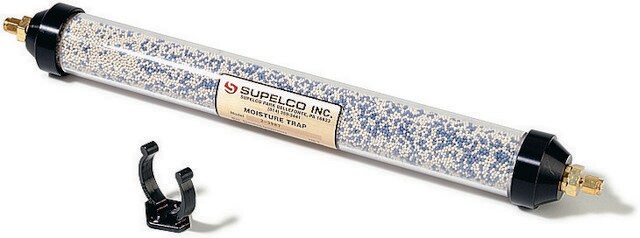223921
Ascarite®
Sodium hydroxide-coated silica, 20-30 mesh
Synonym(s):
Ascarite CO2 adsorbent
Sign Into View Organizational & Contract Pricing
All Photos(3)
About This Item
Quality Level
form
granular
particle size
20-30 mesh
InChI
1S/Na.H2O/h;1H2/q+1;/p-1
InChI key
HEMHJVSKTPXQMS-UHFFFAOYSA-M
Looking for similar products? Visit Product Comparison Guide
General description
Ascarite® is sodium hydroxide coated silica mainly used as carbon dioxide adsorbents. It is the second generation of the original Ascarite, which was derived from granular asbestos. Ascarite rapidly and quantitatively adsorbs carbon dioxide, (and acid gases), and is useful in a number of analytical and microanalytical procedures, physiological studies, etc.
Application
Ascarite® can be used as a carbon dioxide (CO2) trap.
Features and Benefits
The material is self-indicating, gradually changing color (to white) within a narrow zone due to the formation of sodium carbonate.
Legal Information
Ascarite is a registered trademark of Arthur H. Thomas Co.
Signal Word
Danger
Hazard Statements
Precautionary Statements
Hazard Classifications
Eye Dam. 1 - Met. Corr. 1 - Skin Corr. 1A
Storage Class Code
8B - Non-combustible, corrosive hazardous materials
WGK
WGK 3
Personal Protective Equipment
dust mask type N95 (US), Eyeshields, Gloves
Certificates of Analysis (COA)
Search for Certificates of Analysis (COA) by entering the products Lot/Batch Number. Lot and Batch Numbers can be found on a product’s label following the words ‘Lot’ or ‘Batch’.
Already Own This Product?
Find documentation for the products that you have recently purchased in the Document Library.
Customers Also Viewed
Reduction of [11C] CO2 to [11C] CO using solid supported zinc.
Dahl K, et al.
Journal of Labelled Compounds & Radiopharmaceuticals, 60(13), 624-628 (2017)
Highly selective iron-based Fischer?Tropsch catalysts activated by CO2-containing syngas
Chun D H, et al.
J. Catal., 317, 135-143 (2014)
Weiqing Liu et al.
Carbohydrate polymers, 93(1), 199-206 (2013-03-08)
Dissolution of waxy corn starch in 1-ethyl-3-methylimidazolium acetate (EMIMAc) was qualitatively studied and compared with gelatinisation process in water. The rheological properties of starch-EMIMAc solutions were investigated in dilute and semi-dilute regions, from 0.1 to 10 wt% over temperature range
Qiang Yu et al.
Bioresource technology, 129, 592-598 (2013-01-12)
Liquid hot water (LHW), dilute hydrochloric acid (HCl) and dilute sodium hydroxide (NaOH) were applied to sugarcane bagasse (SB). Application of the same analytical methods and material balance approaches facilitated meaningful comparisons of glucose and xylose yields from combined pretreatment
Xin-Cun Yao et al.
Carbohydrate polymers, 94(1), 88-90 (2013-04-03)
Most polysaccharides cannot dissolve in water but can be hydrolysed using hydrogen peroxide (H2O2) to yield a water-soluble product. This study presents a method of preparing water-soluble polysaccharides from peach gum by hydrolysis using H2O2. Extraction was monitored by the
Our team of scientists has experience in all areas of research including Life Science, Material Science, Chemical Synthesis, Chromatography, Analytical and many others.
Contact Technical Service



